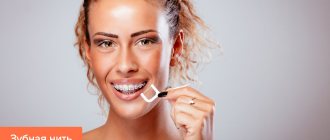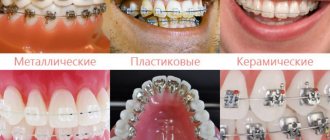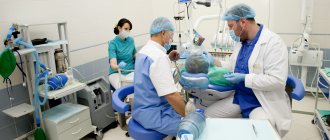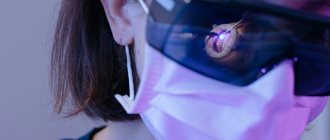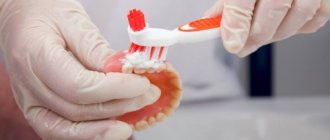The brushes are included in the kit for caring for teeth with braces.
Externally, this brush has an elongated handle and a removable elongated head. This device is very effective for hard to reach places. Removing tiny food particles helps prevent tooth decay and other diseases.
On sale you can find brushes with several interchangeable nozzles of different lengths. The longer ones are for the front incisors, and the shorter ones are for the back molars. In addition, they may vary in the stiffness of the bristles. Dentiki doctors recommend replacing tips after two weeks of use.
When moving, you should be careful when pressing so as not to injure the gums.
Other devices
We include two auxiliary tools in this category:
- Irrigator. It delivers a thin stream of water or solution under pressure, which “knocks out” food particles.
- Flosses. This is a convenient device for using dental floss. The best thread is fluorine-containing, waxed. This strengthens the enamel and prevents the appearance of caries.
Is it necessary to carry out hygienic cleaning before installing braces?
If there is evidence for this, then it is necessary, since braces must be installed on clean enamel. It is important that there is no accumulation of plaque underneath them, otherwise caries may develop under the braces. In addition, if there is a lot of plaque, it will be difficult to remove it with braces - it is better to do this before the system is fixed.
However, if you have recently had dental hygiene, it is better to postpone the procedure a little and go through it 2-3 months after installing the braces system - it will be much more effective.
What products are needed to care for teeth with braces?
Caring for teeth with braces
| Name | Description |
| Various toothbrushes | Braces are placed in stages: first on the upper jaw, after a few weeks or even months - on the lower jaw. Therefore, you can brush your teeth without braces as usual. But for those teeth that have braces attached, it is better to purchase a brush with a V-shaped groove specifically designed for braces. Additionally, thin mono-tuft brushes will be useful, which will allow you to reach narrow and hard-to-reach places and better clean the braces themselves. Try different options - this way you can choose the best and most convenient one for yourself, and your attending physician will evaluate how well you perform hygiene with the chosen products. |
| Toothpaste | After installing braces, teeth often break, the enamel becomes thinner, and the teeth react sharply to external influences. Therefore, a toothpaste for sensitive teeth must be in your arsenal. After the condition of the enamel is normalized, it can be changed to whitening or anti-plaque. Do not forget to change the paste every 3-4 months or even more often, selecting it in accordance with the problems that you have. |
| Interdental brushes and/or dental floss | Use after every meal, carefully cleaning the interdental spaces. Also use brushes under the arch and along the top of the plates - these are places where pieces of food often remain. Choose the product of the desired thickness - start with the thinnest ones and choose the option that is right for you, taking into account the size of the spaces between the teeth. It is better if the kit includes brushes of different sizes - for different intervals. |
| Irrigator | It is not only possible to use it, but also absolutely necessary to clean the interdental spaces. |
| Mouthwash | Choose any one that suits you - you can leave the one you used before installing braces. |
| Protective wax | Buy it on the first day, since braces (their protruding edges and arch) can rub the inside of the cheeks, especially in the first days. |
| Travel set | At first glance, this may seem like a waste of money, but this is a great option for those who travel often or lead an active lifestyle - throw this set in your purse and carry out hygiene after any snack. You can form it yourself by packing all the necessary products in a small cosmetic bag. |
Irrigators for braces: orthodontic attachments
The irrigator can be equipped with various attachments. Main types:
- Standard. Suitable for routine cleaning of the oral cavity. It has a curved shape and a small diameter nozzle. With its help, 1-2 teeth are washed. It does not allow you to completely clean your braces.
- Massage room. Equipped with a round head with bristles designed to massage the gums, which helps stimulate blood circulation in the gums and strengthen the tissue. Doctors advise using an irrigator with massage attachments for people who wear braces. Metal elements cause discomfort and pain due to constant displacement of teeth. A light massage of the gums can reduce pain and speed up the regeneration process.
- Periodontal. Used to clean periodontal pockets. Indicated for periodontal diseases. Also suitable for cleaning braces.
- To remove plaque. These attachments are equipped with several tufts of bristles that remove deposits from teeth through mechanical action. A pulsating jet of liquid performs additional cleaning. Plaque removal attachments can be used to maintain braces.
- Orthodontic. Designed for cleaning any orthodontic structures. It has an elongated nozzle and a curved neck with a narrow tip, which allows you to penetrate hard-to-reach places, clean locks and places where braces come into contact with your teeth.
Stationary irrigators are produced with a large number of attachments. As a rule, the kit includes 1-2 standard ones and several special ones. They can be purchased separately, you just need to make sure that they fit your specific device model. Which irrigator should I buy for braces? Let us list the main selection criteria.
Can I use an electric toothbrush?
Ultrasonic is not possible, conventional electric is possible. The first can lead to the plates coming off, the second should not have a moving head and strong vibration - this will not harm the braces, but it will be inconvenient for you to use such a brush, since the bristles will get stuck. You can use several toothbrushes at once - a regular one to clean the inner surface of the teeth, and an orthodontic one to clean the outer surface where the braces are located.
“The braces are fixed quite securely - you need to try hard to peel them off the surface of the teeth. Therefore, hygiene must be carried out without fear and in no case reducing its intensity, making allowances for braces. If the care is poor, after removing the system we will find caries and white spots on the enamel.”
Rustamova Gunel Bakhmanovna, dentist-orthodontist, work experience more than 4 years make an appointment
Cleaning technique
While wearing braces, it is important to follow the rules of brushing your teeth. Special brushes help prevent caries and the development of harmful microbes, but only when used correctly.
Rules for using orthodontic device products:
- At the beginning of the hygiene procedure, use a brush with bristles in the shape of the letter V. The paste should be applied to dry bristles. Then they begin to move the brush horizontally. The front teeth are brushed first, and then the side teeth. Using sweeping movements, the brush is directed from the gum line to the cutting edge.
- Then you need to take a single-beam model. Using this product, you should clean the surface of each element of the braces and the locking mechanism. Next, the interdental space and chewing surface of the molars are processed.
- The brush is passed under the arch. Then, with rotational movements of the brush, the vestibular surface of the enamel, the orthodontic arch and the area where the bracket system adheres to the tooth are cleaned. During this procedure, it is recommended to make a reciprocating movement vertically.
After using special devices, take a classic brush, which is used to clean the lingual and chewing surface. At the end of the procedure, you should use a dental rinse.
What diet should you follow?
There are three main rules that must be followed after installing braces:
- avoidance of excessively hard and “sticky” foods – nuts, seeds, toffees, chewing gums,
- hard fruits and vegetables, meat must be cut into small pieces, chewing with side teeth,
- food and drinks should be warm, but not hot - this can lead to the records coming off.
Your diet should remain unchanged, with the exception of the three points listed. Do not overuse liquid and soft foods - your teeth must receive stress for normal functioning. You can minimize the consumption of viscous foods (chocolate, waffles, chips) - but not because they are prohibited, but because they accumulate on braces and under the archwire. They will simply be very difficult to remove.
Diet rules while wearing braces
For effective treatment, you need to adjust your diet.
- Avoid solid foods - tough meats, nuts, raw vegetables and fruits, crackers and other foods that can damage the braces.
- Avoid sweet and sticky foods - chocolate, marmalade, marshmallows, nougat, and chewing gum can stick to your braces. Cleaning the system from such products is a difficult and dangerous task; the locks can be damaged or become unstuck. In addition, large amounts of sugar provoke the growth of bacteria in the oral cavity.
- Avoid foods with dyes—wine, soda, strong tea, or colorful candies can tint your braces an undesirable shade.
- Too cold and hot dishes are prohibited - temperature changes can cause braces to come off.
How to eat immediately after getting braces
In the first 1-2 weeks after installing braces (as well as after their activation), especially with a significant defect and the choice of ligature structures (they put more pressure on the teeth than self-ligating ones), you will experience pain. The degree of intensity is completely different and depends on many factors, including your sensitivity. Therefore, if at first you find it painful and unpleasant to eat your usual food, change it to a more liquid one - give preference to soups, dairy products, yoghurts, or puree the main dishes. This will reduce the load on the teeth and reduce painful manifestations.
How much does it cost to have braces removed?
When your teeth are in the correct position, the final stage of treatment begins, which involves removing braces and installing retainers or making a retention mouthguard. These are also not free services and their cost in our clinic will be as follows:
- Removal of braces - from 30,000 rubles;
- Retention mouth guards for two jaws – 20,000 rubles.
After the braces are removed, it is necessary to clean the teeth and polish the enamel. We have already written about the cost of professional oral hygiene services above. It is also advisable to undergo a tooth enamel remineralization procedure, which strengthens and restores the natural enamel coating of the teeth. The cost of remineralization depends on the type of drug that will be used in the procedure.
Having told you about the main cost items for installing braces in Moscow, let's look at the questions that patients most often ask orthodontists.
Take a short test and calculate the cost of treatment!
Take a short test
Rules for daily hygiene care
If you have braces, you should make it a rule to take care of your teeth every day - morning, evening and after every snack. This will help maintain healthy teeth and a snow-white shade of enamel after removing braces.
- Brush your teeth with a brush and toothpaste in the morning and evening. If you have a special brush, it is necessary to carry out horizontal movements along the arch of the braces (there is a recess inside the bristles for the arch). Use a regular brush without strong pressure, using both horizontal and vertical movements. Move the head actively, clean each record separately,
- After the main cleaning, use a single-tuft brush or brushes to clean every gap between the brackets/archwires, the surface of the teeth, as well as the plates themselves, top and bottom. Pay special attention to the brackets that are located on the farthest teeth - it is on them that the largest amount of plaque accumulates, since it is with these elements that we chew food,
- Rinse your mouth with water and mouthwash for 1-2 minutes.
Cleaning can also be supplemented with an irrigator (can also be directed at the plates - the pressure should be reduced only in the presence of ceramic and sapphire systems) and dental floss.
Pesitro Orthodontic (Brazil - China)
This toothbrush for braces is sold complete with a protective cap, a convenient stand and special instructions for all braces wearers. The instructions once again remind you of what you should not eat after installing the devices and how to properly care for your oral cavity during the period of orthodontic correction. It is distinguished by bright shades of both the bodies themselves and the bristles.
In terms of hardness – medium. The number of bristles is 2900 pieces. Bristle material is nylon. With a compact head to avoid soft tissue injury and better maneuverability. Cost – from 300 rubles.
“I ordered this ozone brush for myself. I really liked that it was bright, and I really wanted rich colors and colors in the middle of winter. Immediately lifts your spirits! She cleans quite well. BUT, almost from the first day of use, the stubble began to creep out horribly, and the hairs constantly get stuck in the braces...” KlavMi, review from the site 32top.ru
PESITRO brand products are safe, have passed all clinical studies and have the necessary quality certificates (for example, FDA from the USA), as well as a certificate of registration in the Russian Federation.
Pesitro Orthodontic
Why do my teeth hurt after installing and activating braces?
In the first days after installation, and subsequently after activation of braces, aching sensations of varying degrees of intensity are possible - the stronger the defect, the greater the pain. When fixing ligature systems, the pressure is greater, so the teeth will hurt more. Soreness in general is a completely normal reaction, since braces from the first minutes after fixation already have an impact on the teeth and change their position.
If the pain is severe, then in the first days after installation or activation of the system, you can take painkillers. But no more than 2-3 days. If discomfort persists, contact your orthodontist for system correction.
What to do if your braces chafe?
For inflammation of the mucous membranes, you can use special gels and ointments that have an antiseptic and soothing effect - for example, Metrogyl Denta, Vinilin.
To prevent inflammation, it is also recommended to use orthodontic wax. The purpose of its use is to isolate and protect soft mucous membranes from solid elements of the system. Apply to sharp protruding parts and replace as they fall off. It is recommended to remove the wax while eating.
Silicone strips for braces, like wax, are used to protect soft mucous membranes. Silicone is presented in the form of strips that can be used to cover one bracket or the entire row. Unlike wax, it does not crumble and is used repeatedly.
What to do if the bracket comes off?
This happens quite rarely. And, as a rule, with budget models that are initially poorly fixed, or after some time after using the system. In such a situation, you need to make an appointment with the orthodontist as quickly as possible, or even come without an appointment during his working hours: gluing the plate will only take a few minutes. Metal braces can be re-glued at least 2-3 times. Ceramic or sapphire - also 1-2 times, but you need to look at their general condition.
It is unlikely that the bracket will be swallowed, since even if it comes off the surface, it will still be fixed to the arch with the help of ligatures or locking fastenings. If the plate does fall off, do not throw it away, but be sure to take it with you to your doctor’s appointment.
How much does it cost to get braces on an adult's teeth?
There will be no noticeable difference between the price of orthodontic treatment for a child and for an adult. The only thing is that the course of bite correction for a child can be shorter, since children’s teeth quickly take the correct position, so some savings are possible on planned visits to the orthodontist. And, in addition, for children, inexpensive metal braces of a classical design are usually chosen - vestibular, with ligatures.
Adults are more concerned about the aesthetics of their teeth, so they often choose lingual and ceramic braces, which is why the price of treatment is higher.
How often should I visit a doctor after getting braces?
If you have ligature systems, you need to visit your doctor monthly. Self-ligating ones also require regular correction, but the frequency is slightly less - every 1.5-2 months. In addition, every 2-3 months you will need professional oral hygiene. And it is better to have it done in the same clinic where you got your braces - your attending physician will carefully remove the arch, you will undergo the procedure, after which he will return the arch to its place. This way the system will not be damaged, and you will get teeth that will be thoroughly cleaned of plaque.
